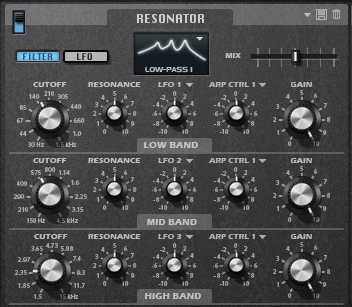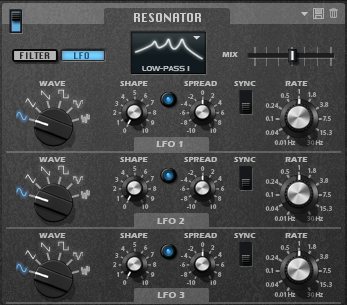Resonator
The Resonator effect comes with 14 predefined filter shapes that determine the basic sound character. In addition to this, three LFOs can be used to modulate each filter individually, which allows for adding extra motion to the sound.
The sound of the human voice or of acoustic instruments is characterized by distinctive formant regions, that is, by resonances in the frequency spectrum that are typical for a particular sound. For example, the vowel “ah” (as in father) sung by a male singer has three characteristic formants: F1 = 570 Hz, F2 = 840 Hz, and F3 = 2410 Hz. The Resonator effect allows you to induce such formant regions to a sound by using three filters that are connected in parallel. You can specify the positions and levels of the formant regions by adjusting the Cutoff, Resonance, and Gain parameters of the filters.
- Resonator Shape
-
Defines the basic sound character of the effect. Each shape is a unique combination of different filter types for the low, mid, and high frequency bands.
Option
Filter Low/Mid/High
Low-Pass 1
LP6/LP6/LP6
Low-Pass 2
LP12/LP12/LP12
Band-Pass 1
BP12/(-1)BP12/BP12*
Band-Pass 2
BP12/BP12/BP12
High-Pass 1
HP6/HP6/HP6
High-Pass 2
HP12/HP12/HP12
Peak 1
LP6/(-1)BP12/HP6*
Peak 2
LP6/BP12/HP6
Bat 1
HP12/BP12/LP12
Bat 2
HP6/BP12/LP6
Wings 1
LP6/BR12/HP6
Wings 2
HP12/BR12/LP12
Wings 3
LP6/(-1)BR12/HP6*
Wings 4
HP12/(-1)BR12/LP12*
*(-1) means that the phase is inverted
- Mix
-
Sets the ratio between the dry and the wet signal.
Filter Page

- Cutoff
-
Adjusts the cutoff frequency of the filter, that is, the center frequency of the formant region.
- Resonance
-
Adjusts the resonance of the filter. The resonance determines how much the formant region is emphasized. With higher settings, the filter self-oscillates, which results in a ringing tone.
- Gain
-
Adjusts the input gain of the filter. The gain determines the level of the formant region.
- LFO Modulation Source
-
Allows you to select the LFO that modulates the cutoff.
- LFO Modulation Depth
-
Adjusts the cutoff modulation of the LFO.
- Arp Modulation Source
-
Allows you to select a controller lane from the Arp page as modulation source.
This determines which MIDI controller is used to modulate the cutoff.
- Arp Modulation Depth
-
Specifies the intensity of the controller lane modulation.
This adjusts the cutoff modulation from the MIDI controller.
LFO Page

- LFO Wave Shape
-
Waveform selects the basic type of waveform. Shape changes the characteristics of the waveform.
-
Sine produces smooth modulation, suitable for vibrato or tremolo. Shape adds additional harmonics to the waveform.
-
Triangle is similar to Sine. Shape continuously changes the triangle waveform to a trapezoid.
-
Saw produces a ramp cycle. Shape continuously changes the waveform from ramp down to triangle to ramp up.
-
Pulse produces stepped modulation, where the modulation switches abruptly between two values. Shape continuously changes the ratio between the high and low state of the waveform. If Shape is set to 50%, a square wave is generated.
-
Ramp is similar to the Saw waveform. Shape adds a gradually increasing amount of silence before the sawtooth ramp up begins.
-
Log produces a logarithmic modulation. Shape continuously changes the logarithmic curvature from negative to positive.
-
S & H 1 produces random stepped modulation, where each step is different. Shape puts ramps between the steps and changes the S & H into a smooth random signal, with the control set fully to the right.
-
S & H 2 is similar to S & H 1. The steps alternate between random high and low values. Shape puts ramps between the steps and changes the S & H into a smooth random signal, with the control set fully to the right.
-
- Spread
-
For each channel of the effect, there is a separate LFO signal. This parameter spreads the phase of the LFO signals across the different channels.
For example, if the effect is used in stereo, positive values shift the LFO phase forward on the left channel and backward on the right channel.
- Sync
-
Allows you to set the Freq parameter in fractions of beats.
- Freq
-
Determines the frequency of the cutoff modulation.